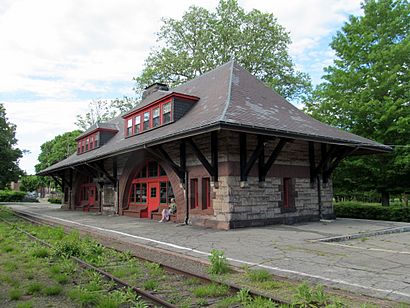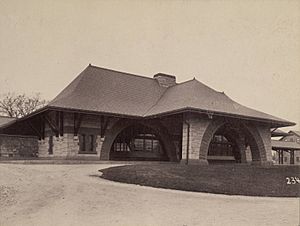North Easton station facts for kids
Quick facts for kids
Easton Village
|
|||||||||||||
|---|---|---|---|---|---|---|---|---|---|---|---|---|---|

The historic Old Colony Railroad Station building. The new MBTA platform would be built just across the track.
|
|||||||||||||
| Owned by | Massachusetts Bay Transportation Authority | ||||||||||||
| Line(s) | Dighton and Somerset Railroad | ||||||||||||
| Platforms | 1 side platform (proposed) | ||||||||||||
| Tracks | 1 | ||||||||||||
| Construction | |||||||||||||
| Bicycle facilities | 8 spaces (proposed) | ||||||||||||
| Disabled access | Yes | ||||||||||||
| History | |||||||||||||
| Opened | May 16, 1855 | ||||||||||||
| Opening | 2030 (proposed) | ||||||||||||
| Closed | September 5, 1958 | ||||||||||||
| Rebuilt | 1881 | ||||||||||||
| Previous names | North Easton | ||||||||||||
| Services | |||||||||||||
|
|||||||||||||
|
|||||||||||||
|
North Easton Railroad Station
|
|||||||||||||
|
U.S. National Historic Landmark District
Contributing Property |
|||||||||||||
|
U.S. Historic district
Contributing property |
|||||||||||||

Old Colony Railroad Station, North Easton as it appeared in 1890
|
|||||||||||||
| Location | 80 Mechanic Street North Easton, Massachusetts |
||||||||||||
| Built | 1881 | ||||||||||||
| Architect | H. H. Richardson | ||||||||||||
| Part of | H. H. Richardson Historic District of North Easton (ID87002598) | ||||||||||||
| Significant dates | |||||||||||||
| Designated NHLDCP | December 23, 1987 | ||||||||||||
| Designated CP | November 3, 1972 | ||||||||||||
The North Easton station is a very old train station building. It was designed by a famous American architect named Henry Hobson Richardson. You can find it in North Easton, Massachusetts. Today, the building is home to the Easton Historical Society.
This station was built in 1881. It served trains carrying people until 1958. Because it's so important, it was added to the National Register of Historic Places in 1972. Later, in 1987, it became part of a special area called the H. H. Richardson Historic District of North Easton. This district is a National Historic Landmark District.
There are plans to bring train service back to this spot. A new station, called Easton Village station, might open here around 2030. It will be part of the South Coast Rail project.
Contents
Station History
Early Train Service
The first train line, called the Easton Branch Railroad, opened on May 16, 1855. It connected Stoughton to North Easton. This line was first part of the Boston and Providence Railroad. Later, in 1866, it became part of the Dighton and Somerset Railroad.
Designing the Station
In 1881, a new station building was ordered. Frederick Lothrop Ames, who was in charge of the Old Colony Railroad, asked for it. This was the same year Richardson designed another building for Ames nearby. A famous landscape designer, Frederick Law Olmsted, planned the station's outdoor areas.
The station is not very big. It has just one floor. It shows Richardson's special style with heavy stone walls and a very large roof. The building runs north to south, with the train tracks on its west side. Inside, it was set up with two large waiting rooms. One was for women, and the other was for men.
Building Details
The outside of the station is made from rough gray granite stones. It has a brownstone band and trim. There are two big, round arches on the long sides of the building. These arches have windows and doors. They are decorated with carvings of a beast's snarling head. Another round arch sticks out on the east side, forming a covered entrance for carriages. The roof hangs out far over the sides. It is held up by simple wooden supports.
End of Service and Preservation
Commuter train service past Stoughton stopped on September 5, 1958. In 1969, the Ames family bought the station from the Penn Central Railroad. They then gave it to the local historical society.
The station was added to the National Register of Historic Places in 1972. This means it's an important historical site. In 1987, it also became part of the H. H. Richardson Historic District of North Easton. This district is a very special historical area.
Future Plans
A new MBTA Commuter Rail station is planned for this spot. It will be called Easton Village. This new station is part of the South Coast Rail project. A long platform, about 800 feet (240 meters) long, will be built across the tracks from the old historic building. This will bring train service back to the area.


